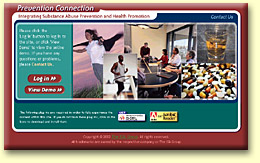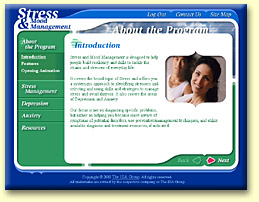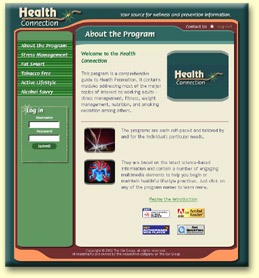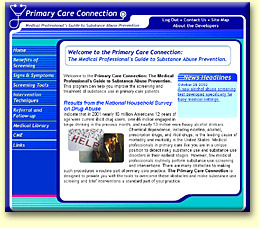 |
        |

|
 |
| Current Projects |
| The Prevention Connection: Integrating Substance Abuse Prevention
and Health Promotion |
 During the last 20 years, approaches to the prevention of drug
abuse have become more numerous and scientifically sophisticated.
However, the development and implementation of prevention training
programs has not kept pace with the considerable advances made
in prevention science and applications. Nowhere is this dearth
of training programs more evident than in the training of workplace
health professionals to deliver advanced prevention training
to working adults. In this Phase II SBIR project, a substance
abuse prevention training program was developed specifically
for health promotion and wellness practitioners, with a focus
on workplace-oriented health promotion practitioners. The web-based
training program uses an interactive, multi-media approach. The
prevention training program focuses on training health promotion
professionals to successfully integrate substance abuse prevention
materials and messages into standard, popular health promotion
programs without losing the impact of the program on the target
health behavior (i.e., nutrition or stress management). The program
also provides information to help health promotion professionals
understand why it is important to integrate substance abuse prevention
and health promotion and presents the business case for substance
abuse prevention. In addition, Prevention Connection provides
an in-depth look at the leading substance abuse prevention models
and theories and includes descriptions of innovative workplace
prevention programs and facts about drugs and their effects.
The program was tested with members of the Worksite Health Promotion
Division of the American College of Sports Medicine. During the last 20 years, approaches to the prevention of drug
abuse have become more numerous and scientifically sophisticated.
However, the development and implementation of prevention training
programs has not kept pace with the considerable advances made
in prevention science and applications. Nowhere is this dearth
of training programs more evident than in the training of workplace
health professionals to deliver advanced prevention training
to working adults. In this Phase II SBIR project, a substance
abuse prevention training program was developed specifically
for health promotion and wellness practitioners, with a focus
on workplace-oriented health promotion practitioners. The web-based
training program uses an interactive, multi-media approach. The
prevention training program focuses on training health promotion
professionals to successfully integrate substance abuse prevention
materials and messages into standard, popular health promotion
programs without losing the impact of the program on the target
health behavior (i.e., nutrition or stress management). The program
also provides information to help health promotion professionals
understand why it is important to integrate substance abuse prevention
and health promotion and presents the business case for substance
abuse prevention. In addition, Prevention Connection provides
an in-depth look at the leading substance abuse prevention models
and theories and includes descriptions of innovative workplace
prevention programs and facts about drugs and their effects.
The program was tested with members of the Worksite Health Promotion
Division of the American College of Sports Medicine. |
| |
| Parent Power - Raising Safe and Drug-Free Kids |
 Substance abuse among adolescents continues
at intolerably high levels. Research indicates that parents
can provide a powerful,
positive influence over their children through warm, authoritative
family management; strong attachments; positive parental modeling;
and less permissive attitudes. The evidence argues convincingly
for prevention programs directed specifically at parents. The
workplace is an underutilized resource for targeting parents.
Although prevention programs for parents exist, very few consider
the adolescent’s stage of development, and fewer still
provide parents with opportunities for individual learning, behavior
modeling, and vicarious learning using interactive, multi-media
technology. Finally, few exist that provide these opportunities
for parents at their convenience. Substance abuse among adolescents continues
at intolerably high levels. Research indicates that parents
can provide a powerful,
positive influence over their children through warm, authoritative
family management; strong attachments; positive parental modeling;
and less permissive attitudes. The evidence argues convincingly
for prevention programs directed specifically at parents. The
workplace is an underutilized resource for targeting parents.
Although prevention programs for parents exist, very few consider
the adolescent’s stage of development, and fewer still
provide parents with opportunities for individual learning, behavior
modeling, and vicarious learning using interactive, multi-media
technology. Finally, few exist that provide these opportunities
for parents at their convenience.
The objective of the research was to develop and test a web-based
adolescent substance abuse prevention program for parents.
The program is designed to raise parents' self-efficacy to
make positive changes in their children's lives. This multimedia
program helps increase parental skills in: 1) maintaining healthy
communication in general and specifically talking to kids about
substance use; 2) using positive and constructive family management
styles; and 3) setting clear, consistent, and developmentally
appropriate limits on adolescent behavior. Details on adolescent
development and interactive sessions, separated into specific
stages of adolescent development, are also included. In addition,
the Parent Power program provides general information on adolescent
substance use, specific information on drugs and their short-
and long-term effects, and the signs and symptoms of substance
use. Two additional program components include: 1) the Safety
Zone, which provides information on other high risk behaviors
and conditions such as sexual behavior, risky driving, violence,
and depression; and 2) Parents and Teens Together, which provides
on-line activities for parents and teens to do together. Parents
can also find links other resources available on the Internet.
|
| |
| Stress And Mood Management |
 Stress, depression and other mental
health disorders are prevalent, disabling conditions that have
substantial effects on the health
and productivity of the work force. Although effective approaches
to the prevention and treatment of these problems are available,
a large proportion of the work force – perhaps a majority
of those afflicted – do not seek interventions for their
problems, largely because of the stigma attached to the mental
disorders, coupled with a lack of exposure to available interventions. Stress, depression and other mental
health disorders are prevalent, disabling conditions that have
substantial effects on the health
and productivity of the work force. Although effective approaches
to the prevention and treatment of these problems are available,
a large proportion of the work force – perhaps a majority
of those afflicted – do not seek interventions for their
problems, largely because of the stigma attached to the mental
disorders, coupled with a lack of exposure to available interventions. The goal of this project, funded by
the National Institute of Mental Health, is to develop and
test an interactive, multi-media
web-based stress and mood management program for the workplace.
By presenting topics of depression, anxiety and substance abuse
within a program of stress management – a relatively
non-stigmatized topic – working adults can acquire the
necessary awareness, skills and motivation to prevent or seek
treatment for these costly disorders. In Phase I, a prototype
stress and mood management program (focusing primarily on the
Stress Management module) was developed. The prototype program
was tested in focus groups of working adults, and interviews
were conducted with human resource managers and workplace health
professionals to assess the feasibility and commercial viability
of the program. Phase II includes the full development and
field test of the program.
|
| |
| Health Connection |
 Most heavy drinkers and users of illicit drugs are working
adults, yet few workplaces provide substance abuse prevention
messages and materials to their work forces. Although research
has shown that substance abuse prevention material is effective
when integrated into workplace health promotion programs, this
approach requires prevention materials (e.g., print and video)
to be inserted into traditional instructor-led seminars. In order
to greatly expand the reach and impact of workplace substance
abuse prevention, this project includes the development of a
web-based health promotion program for the work force that has
substance abuse prevention material woven throughout the content.
With such a program, employees who access a given health promotion
topic (e.g., stress management, fitness, etc.) will also be presented
with substance abuse prevention material that is related to the
particular health promotion topic. Just as important, the completed
Health Connection will contain the four most popular health promotion
programs – Stress Management, Nutrition/Weight Management,
Fitness, and Smoking Cessation – all on the Web. In Phase
I, a prototype health promotion/substance abuse prevention program
was constructed and pilot-tested. In Phase II, The Health Connection
program will be completed and field-tested in a randomized design
at a worksite. It is expected that The Health Connection will
both improve health practices and reduce substance abuse in a
significant proportion of the work force. Most heavy drinkers and users of illicit drugs are working
adults, yet few workplaces provide substance abuse prevention
messages and materials to their work forces. Although research
has shown that substance abuse prevention material is effective
when integrated into workplace health promotion programs, this
approach requires prevention materials (e.g., print and video)
to be inserted into traditional instructor-led seminars. In order
to greatly expand the reach and impact of workplace substance
abuse prevention, this project includes the development of a
web-based health promotion program for the work force that has
substance abuse prevention material woven throughout the content.
With such a program, employees who access a given health promotion
topic (e.g., stress management, fitness, etc.) will also be presented
with substance abuse prevention material that is related to the
particular health promotion topic. Just as important, the completed
Health Connection will contain the four most popular health promotion
programs – Stress Management, Nutrition/Weight Management,
Fitness, and Smoking Cessation – all on the Web. In Phase
I, a prototype health promotion/substance abuse prevention program
was constructed and pilot-tested. In Phase II, The Health Connection
program will be completed and field-tested in a randomized design
at a worksite. It is expected that The Health Connection will
both improve health practices and reduce substance abuse in a
significant proportion of the work force. |
| |
| Web-Based
Diabetes Prevention Program For The Workplace |
| Type 2 diabetes, a costly and debilitating disease, has reached
epidemic proportions in the U.S. Risk is strongly associated
with factors related to lifestyle behaviors. Individualized,
interactive, multimedia interventions aimed specifically at primary
prevention and early detection of Type 2 diabetes hold great
promise, yet are generally lacking in the workplace and elsewhere.
The Internet currently falls short of its potential to deliver
a sophisticated behavior change program aimed at Type 2 diabetes
prevention, detection and control.
The purpose of this project is to develop and test an innovative,
web-based multimedia program aimed at working adults at risk
for Type 2 diabetes and designed to reduce or ameliorate modifiable
risk factors through health-related behavior change. The program,
entitled, Turning Point, is based on a well-tested health behavior
change model, which is firmly rooted in social learning and
health behavior change theories.
Phase I includes the development of
the final structure and content of the program and prototype
testing with experts and
focus groups drawn from the target audience. Phase II includes
the completion of the program and a rigorous field-test with
the target audience.
|
| |
| Parents'
Guide To Child Nutrition And Health |
| Five of the leading causes of death
in the U.S. can be linked to diet and exercise. Evidence indicates
that lifelong dietary
patterns are typically established early and recent studies show
positive associations between childhood diet and later cancers.
However, children’s diets often do not meet the minimum
recommended requirements and many children do not engage in sufficient
physical activity. Parents can have a major impact on their children’s
eating and exercise practices. Unfortunately, many parents lack
the awareness, motivation and/or skills to ensure that their
children are practicing healthful eating and exercise habits. The objective of this project is to
develop and test a multimedia program for parents designed
to promote healthful child dietary
and exercise practices and reduce children’s risk of
cancer and other chronic diseases. Phase I includes the development
of the preliminary structure and content of the program, prototype
development, and focus group testing with parents. Phase II
involves the full development of the program and an evaluation
of program effectiveness through a rigorous field test with
parents.
|
| |
| A Web-Based
Program On Youth Mental Health For Parents |
| Emotional problems in youth are a common and serious health
concern. Research indicates that depression in adolescence is
increasing and may be starting earlier in life. Interventions
designed to give parents the information and skills necessary
to recognize and intervene when emotional problems are detected
hold great promise. Individuals and health organizations have
begun to mobilize and share information for families with children
who suffer from mental disorders via the world-wide-web. Despite
this progress, most of the websites currently addressing adolescent
depression or anxiety fall short in this effort.
The purpose of this project is to develop and test an innovative
web-based multimedia program aimed at parents and designed
to prevent mental health problems in youth. The program will
incorporate interesting audio and visual segments and provide
scientifically sound information that is accessible to parents
from varying educational backgrounds. In Phase I, the final
structure and content of the program were developed and a prototype
was tested with focus groups of parents. Phase II includes
the completion of the program modules and field testing the
program with working parents in a pretest/posttest randomized
design.
|
| |
| Substance
Abuse Education Website For Primary Care |
 Results from the National Household
Survey on Drug Abuse indicate that in 2001 nearly 16 million
Americans 12 years of age and
older were current illicit drug users, over 45 million engaged
in binge drinking in the previous month, and nearly 13 million
were heavy alcohol drinkers. Chemical dependence, including nicotine,
alcohol, prescription drugs, and illicit drugs, is one of the
leading cause of morbidity and mortality in the United States.
Medical professionals in primary care like family medicine, internal
medicine, pediatrics, and, in some cases, gynecology who routinely
provide preventive health care and rely on routine screening
to detect diseases and promote wellness are in a unique position
to detect risky substance use and substance use disorders in
their earliest stages. However, few medical professionals routinely
perform substance use screening and interventions. Indeed, Healthy
People 2000: National Health and Disease Objectives for Reducing
Alcohol and Other Drug Problems specifically established a goal
for the year 2000 to “Increase to at least 75 percent the
proportion of primary care providers who screen for alcohol and
other drug use problems. The American Medical Association currently
recommends that physicians screen all patients for alcohol and
other drug abuse and the American Nurses Association supports
the role of professional nurses, in all settings, to assess for
substance abuse problems. Results from the National Household
Survey on Drug Abuse indicate that in 2001 nearly 16 million
Americans 12 years of age and
older were current illicit drug users, over 45 million engaged
in binge drinking in the previous month, and nearly 13 million
were heavy alcohol drinkers. Chemical dependence, including nicotine,
alcohol, prescription drugs, and illicit drugs, is one of the
leading cause of morbidity and mortality in the United States.
Medical professionals in primary care like family medicine, internal
medicine, pediatrics, and, in some cases, gynecology who routinely
provide preventive health care and rely on routine screening
to detect diseases and promote wellness are in a unique position
to detect risky substance use and substance use disorders in
their earliest stages. However, few medical professionals routinely
perform substance use screening and interventions. Indeed, Healthy
People 2000: National Health and Disease Objectives for Reducing
Alcohol and Other Drug Problems specifically established a goal
for the year 2000 to “Increase to at least 75 percent the
proportion of primary care providers who screen for alcohol and
other drug use problems. The American Medical Association currently
recommends that physicians screen all patients for alcohol and
other drug abuse and the American Nurses Association supports
the role of professional nurses, in all settings, to assess for
substance abuse problems.
Given the wide support for the screening of alcohol and other
drug abuse in primary care settings, it is unusual to note
that very little such screening is actually conducted. Indeed,
research indicates that 41%-94% of primary care physicians
fail to recognize substance abuse in their outpatient population.
The lack of adequate training in the detection and treatment
of substance use and the fact that substance use is generally
considered a mental health problem and not a medical problem
are two barriers to the routine assessment of substance use
by primary care practitioners. The goal of this project is
to create a technologically innovative, multifaceted, web-based
training program for primary care physicians, nurses and nurse
practitioners that will serve two purposes. First, the program
will provide a comprehensive training course for nurses and
physicians in which they can receive continuing education and
continuing medical education credit. In addition, based on
feedback from the usability tests, specific elements of the
program will be available for physicians and nurses in practice.
In Phase I, a prototype program, entitled Primary Care Connection,
was developed and pilot tested (including a usability test)
with physicians, nurses, and nurse practitioners. In addition,
ISA surveyed physicians and nurses regarding their screening
practices and the barriers to substance use screening in primary
care settings. Phase II includes the full program development
and testing with groups of primary care professionals.
|
| |
| A Web-Based
Program To Prevent Prescription Drug Abuse |
| Prescription medications are an effective way to bring improvements
in the health of numerous individuals, however, many patients
fail to receive proper education and counseling prior to the
initiation and during the course of a pharmaceutical treatment.
Critical to this issue is the fact that medications such as tranquilizers,
sedatives, analgesics, and stimulants have the potential for
abuse and may lead to drug misuse, dependence, and addiction
if not administered and managed properly. Data from National
Household Survey on Drug Abuse indicated that the misuse and
abuse of prescription medications is on the rise. While drug
abuse affects many Americans, the National Institute on Drug
Abuse recently noted that there appears to be increased concern
for older adults, adolescents, and women.
The purpose of the project is to develop and test an innovative
web-based educational program designed to prevent prescription
drug abuse among working women. The program contains important
information on the safe use of medications with abuse potential
and on alternatives to taking medications. Phase I includes
the development and focus group testing of the prototype structure
and Phase II involves the full development and field test of
the program and preparation for marketing.
|
| |
| Web-Based
Alcohol Abuse Prevention For College Students |
| College is a time when a large proportion of young people engage
in heavy and binge drinking, putting themselves at risk for a
variety of health and safety problems. The proposed effort will
develop and test a web-based multi-media alcohol abuse prevention
program aimed at college students, with specific paths for freshmen.
The program will have an overall stress management/well-being
focus and will also include sections addressing sexual health
and safety. A major section of the program will be devoted to
alcohol abuse prevention, and alcohol abuse prevention material
will be interwoven throughout the other sections.
Phase I involves the preliminary structure and content development
and pilot-testing with focus groups of college students drawn
from two universities. Phase II involves full program development
and rigorous field testing with college students as well as
preparations for marketing.
|
| |
| Community Based Study Of Creating Lasting
Family Connections And Stress Management |
| This project combines a CSAP model program, Creating Lasting
Family Connections (CLFC) with a program integrating substance
abuse prevention into stress management (The Stress Management
Connection). The quasi-experimental evaluation includes pre,
post, and follow-up surveys. The goal of the project is to assess
the effectiveness of implementing the combined program in a community-based
setting as opposed to faith-based (CLFC) or workplace-based (Stress
Management) settings where the programs have been previous been
implemented. The project is a collaboration between ISA and the
Prevention Unit of the Fairfax County (Virginia) Community Services
Board. The CLFC program includes separate modules for parents
and youth, as well as combined parent/youth sessions. The program
covers parenting practices, parent-child communication, and substance
abuse prevention. The Stress Management Connection targets parents
and focuses on positive stress management techniques. Three cohorts
of families are being used to maximize sample sizes and the power
of the study. Survey data are being collected from parents and
youth at three times: (1) before they receive program services
(pre-intervention), (2) shortly after they complete the sessions,
which will be roughly six months after the pre-intervention data
collection (post-intervention), and (3) roughly six months later
(follow-up). Multivariate statistical analyses are being used
to evaluate program effectiveness. |
| |
|


|
|